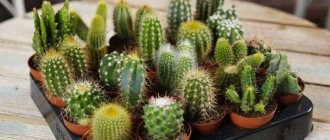Indoor plants need daily care and winter is no exception. It is believed that since it is time to rest, the green pets can be left alone for a while. A cold window sill, heating appliances, dry air and lack of light can cause significant harm, and hibernation can result in losses. We will tell you how to properly care for indoor pets in winter in this article.
General rules for caring for indoor plants
In winter, the days become shorter, solar activity decreases, and intracellular processes in plants stop. Conditions of care during this period change and depend on the belonging of the plants to a certain category.
- Corm flowers. The above-ground part of bulbous and tuberous flowers completely dies, and all nutritional elements are stored in the underground part. Such plants do not require special care. They are transferred from the windowsill to a dark and cool place.
- Shade-loving plants. In winter, it is best to move them closer to the window. Despite their shade tolerance, insufficient lighting can play a cruel joke and deprive them of their decorative value.
- Heat-loving plants. Avoid keeping them in places where there is a draft. Streams of cold air, even after a single ventilation, can cause irreparable damage, such as frostbite.
- Tropical, moisture-loving plants. Winter is a real test for them. Move exotics away from radiators, provide lighting and periodically shower with a spray bottle.
LiveInternetLiveInternet
Post Quote Passion
Read in full In your quotation book or community!
Winter care for indoor plants
In winter, when there is only white outside the window
And besides, it’s cold, we are especially happy about indoor plants, which with their bright colors remind us of a warm and comfortable summer.
However, in order for plants to really please, you need to know the rules of winter care for indoor flowers, because autumn and winter are considered a critical period in their life. It is at this time that many plants stop intensive growth and enter a state of dormancy. Low temperatures outside the windows, drafts, dry air, lack of light - these are all the things that worry the amateur gardener. How to preserve indoor flowers in winter? Equipping a window sill
On cold days, the air temperature near the window glass is often +5, and ice may even form on its lower edge. This means that the window sill should be insulated without interfering with the plant’s natural light, which is already scarce.
In severe frosts, cover the window with plastic film using tape. Just under the frame, place a roll of several newspapers or a foam roller wrapped in film. Insulate the window sills with polystyrene foam plates, on which you place the pots in pallets. Move heat-loving plant species to warmer locations or place them in hanging baskets. Balsams, begonias, Saintpaulias, gloxinias, echinanthus do not tolerate cold; ferns, aloe, and spurge are also not cold-resistant. More tolerant of low temperatures are chrysanthemums, geraniums, some bulbous plants, and wintering Petunias, which can withstand cold snaps of up to 5-7 degrees. To increase the temperature in the room during severe frosts, remove all coverings from the central heating radiators, lift the curtains, place reflectors behind the radiators - special foil plates or just a large mirror. Remove the excessive dry air that occurs in these cases by frequently spraying the plants, and on large plants, wipe the leaves.
Ventilation and indoor plants
Air ventilation is necessary not only for people, but also for plants. However, the combination of severe frosts outside the window and an open window is very risky. Therefore, place the flowers on the windowsill so that the stream of cold air does not hit them in any way. Pots can stand safely on the side of the window if you cover them with a paper or film shield during ventilation. If for some reason your flower is frozen, then give it a completely cold shower - and it may go away. If the process is irreversible, then cut off the entire plant or its individual frozen parts.
Winter care for indoor plants: 6 rules
How to properly care for indoor flowers in winter? Water more - many housewives think, because in winter the heating works in the apartments and the air becomes dry. But is this true? Every day the living conditions for indoor plants are getting worse, as the days are getting shorter and there is no longer enough sunlight. The nights are getting colder, heating devices completely change the microclimate in the room, due to which the plants do not have enough humidity, and as a result they begin to experience discomfort. 1. Winter watering and spraying
If the plants are located in the back of the room, where it is hot, then the soil in the pot dries quickly and you will have to water more often.
If they overwinter on the windowsill, where it is cooler, the soil remains damp for a long time and needs to be watered less often. To prevent stretching and yellowing of the leaves, in winter the plants should be allowed to rest, stopping their growth. They need to be watered less often, only as a last resort, when the soil begins to dry out. But at the same time, it is necessary to increase spraying, otherwise the tips of the leaves will begin to wither, which over time can lead to death. Also loosen the soil surface more often to allow air to penetrate to the roots. It’s not for nothing that this method is called “dry watering.” It is not recommended to spray some types of plants, for example violets, as the leaves will begin to rot. They should be placed on a tray containing constantly wet expanded clay or pebbles. Cacti and other succulents are hardly watered in winter. Ornamental leaf plants in winter still need moderate watering in winter, as the top layer of soil dries out. For flowering plants, the soil should be kept slightly moist even in winter. Only especially moisture-loving plants (azalea, calamus, cyperus) need waterlogging all year round. 2. Retirement
There are types of green pets that require retirement in winter, for example, cacti; for this, watering should be gradually reduced and fertilizer should not be applied at all.
3. Feeding and lighting of plants
It is advisable not to feed all plants that do not show signs of active growth at all: minerals are poorly absorbed - they will salt the soil and can even kill the roots. Those that actively grow all year round (this especially applies to large plants - monstera, ficus, palm trees, hibiscus) can be fertilized, but less often than in spring and summer, about once a month. In winter, it is better to place plants closer to the window glass. You can also provide additional lighting using fluorescent lamps. It is recommended to feed the plants approximately once a month from November to February. In winter, the dose indicated on the package is halved. Indoor plants that bloom in autumn or winter need to be fed regularly. Such plants include eucharis, callas and cyclamens. It is advisable to give preference to granular fertilizers. You should take care of lighting, because flowering plants need a lot of light for flowers to appear.
4. Pest control
Do not forget about pests; even in the winter months they actively reproduce, which is facilitated by too dry air in the apartment.
It is advisable to regularly inspect all plants and remove flowers and leaves that have wilted. Pests are primarily fungal and bacterial rots. Low temperatures are favorable for the development of fungi. If it is cold on the window, the soil in the pots takes a long time to dry out - conditions arise for fungal microflora, and the risk of damage to the roots increases. This is especially true for succulents (cacti, mesembryanthemums), swallowtails (stapelias) and euphorbias. Control measures: - do not water plants with wet soil; - water succulents when the stems or leaves begin to wither - once every 2-3 weeks or less; - Do not water cacti and lithops at all. 5. Comfort and hygiene
Leaves should be wiped regularly if dust has accumulated on them and if the size of the leaves allows this.
It is recommended to wash small indoor plants in the shower, after covering the ground with film. Remember that all green pets are afraid of sudden drops in temperature and drafts. 6. Transplantation
In winter, it is better to avoid it. Plants are in a dormant state - in this phase of the life cycle, attempts at propagation and transplantation will not meet with “understanding” from them. Transplantation for vital reasons, when the plant is very sick (for example, the roots have rotted from excessive watering), is necessary in any season. The end of winter is the most favorable time for actively replanting indoor plants. Daylight hours increase and plants begin to grow again. They actively form new roots, so it is during this period that it is easier for them to get used to the new planting site. However, it should be replanted if the plant becomes too crowded in the old pot. Carefully remove the plant from the pot. If there is a strong interweaving of roots, then replanting is necessary. Postpone pruning and pinching until March-April. Leave propagation until the spring, too, except in cases where you really want to share a cutting with someone.
December
Winter is in full swing with short days, poor lighting, and air that is too dry for indoor plants.
In December, a humidifier is especially important to somehow increase its humidity. It's time to create a New Year's red and green composition from red amaryllis, poinsettias, ardisias and plants with dark green leaves. In mid-December, you can plant grains of exotic fruits (date palm or citrus fruits) in a mini-greenhouse. Be sure to heat tap water before watering! If you place pots of plants next to each other, to make them lighter, do not move them close to each other. Let the air pass freely between them. Regularly remove yellowed or dry leaves, trim overgrown or too weakened shoots so that the plants always remain beautiful. Once a month, you can add shine to dense leaves using a special aerosol. In the middle of the day, ventilate the room by rearranging the plants first so as not to freeze them. Increase the humidity, but do not wet the leaves too much. If flower bulbs have sprouted, place them closer to the light. At night, lower the temperature in the room slightly, giving the plants a short break. January
At this time, most plants “sleep” in vegetative dormancy.
It is worth watering them less often, reducing the amount of water for each watering. The soil must dry out between two waterings; 15 minutes after watering, always pour the water out of the pan. In January, water cacti and succulents every 12-13 days in a warm room and every 20 days in a cool room. It is better to use botanical scissors or mini pruners to trim dry shoots. Shorten the stems if they become too long due to lack of light. Cut off dry or brownish ends on the leaves, just be careful not to damage the green part of the leaf - then the plant will begin to deteriorate. Increase the air humidity in the house, spray the leaves of plants with soft and lukewarm water. Place all the pots side by side on a layer of expanded clay placed in a small amount of water. This will reduce the negative impact of central heating. Ventilate the room without leaving the plants in a draft. Fertilize plants that are about to bloom. Spray flowering plants regularly, but do not wet the flowers. February
Houseplants begin to awaken from winter hibernation. It's time to put them in order, sweep away the soil and pots. Use a warm, damp sponge to remove pore-clogging dust from dense, large leaves. Rinse small leaves in the shower. Using a brush, dust off cacti, succulents, and hairy-leaved plants. Spray the leaves of indoor palm trees, especially generously from the underside, to prevent red spider mites from attacking them. Leaves should dry before nightfall. Polish the fleshy leaves of ficus rubber, monstera and philodendron. Prepare in advance for spring plant replanting. Let the necessary tubs or pots, substrates, expanded clay for drainage, supports, pallets and fertilizers be purchased. Remove scale insects by hand and trim dried branches that have suffered from powdery mildew. In February you can buy azaleas, cyclamens and primroses. They will bloom longer if you move them to a cool room overnight. Reduce the power of heating devices at night: this will help the plants feel better. Do not spray the velvety leaves of Saintpaulias and begonias. Rotate flower pots for even lighting. Gradually increase watering. The most moisture-loving plants should receive water twice a week in February. Gradually resume active watering of cacti and succulents. Use non-limestone water to water gardenias, azaleas, and ferns. Divide the bushes during replanting if they feel crowded in the pot. Ventilate the room regularly, but still protect the plants from cold drafts and sudden drops in temperature. For climbing plants, trim off any hairless stems and support the longest shoots.
Features of watering indoor flowers in winter
In winter, all plants do not need as frequent watering as in summer. The soil should be moistened when the top layer in the pot dries. Avoid stagnation of water - with frequent watering, the roots will rot.
Cacti are a category of plants for which regular watering is contraindicated. It is enough to moisten the soil in pots 2 times a month. It is advisable to supply water not on top of the pot (so that water does not linger in the intercostal folds and spines), but through the tray.
Amaryllis begin to be watered only when a flower shoot appears from the bulb.
Reproduction
Cuttings
February is a favorable time for propagating plants by cuttings. Cuttings are taken from Araucaria, Sheffera, Aphelandra, Codium, Crossandra, Osmanthus, Stevanotis, Raphiolepis. In order for the cuttings of these plants to take root, soil heating is used.
When propagating araucaria, it is preferable to take the apical cutting from the main trunk. To ensure rooting of cuttings, you can use a stimulator - it will speed up the process of root formation.
For propagation of aphelandra, well-developed leafy but not yet coarsened cuttings are used. Apical cuttings form roots on the twentieth - thirtieth day, and aphelandra stem cuttings form fifty - sixty days.
Raphiolepis and osmanthus are propagated using lignified stem cuttings; roots form in 25–30 days.
Stephanotis is propagated by semi-lignified shoots with at least two internodes, and the leaf blades should be shortened by one third. Young roots of the plant appear in a month.
In February, indoor flowers such as jasmine sambac, begonias, hydrangeas, and clerodendrums require cuttings.
Seeds
Seeds of evergreen begonia, Waller's balsam, and zonal pelargonium are sown for seedlings in February.
Too small begonia seeds are sown with snow. On a light substrate consisting of sand and leaf soil in a ratio (1:3), snow is settled (1 cm layer) and lightly taken.
The seeds are evenly placed on top. Subsequently, the snow will begin to melt and draw the seeds into the substrate. The container with seedlings is placed in a transparent plastic bag and kept in a bright room, darkened from the sun, while the film should not touch the ground. Waller's balsam seeds are germinated in light.
Children will be interested in the idea of planting seeds of exotic fruits - kiwi, avocado, persimmon, date. After germination, entrust the young gardener with the care and maintenance of the plant. This will not only allow the child to learn to love nature, but will also make him responsible and diligent.
Spraying indoor plants
Radiators and other heat sources gradually make the air dry. Green pets react negatively to a lack of moisture - the tips of the leaves dry out, turn yellow, and the decorative quality of the plants decreases. In addition, dry air causes spider mites to appear. Despite its microscopic size, it causes significant harm.
To avoid this trouble, you must:
- wipe the leaves of plants with a damp cloth, spray;
- use humidifiers;
- place glasses of clean water next to the pots;
- install flowerpots in pallets with wet expanded clay;
- hang towels soaked in water on the radiator.
Fight diseases
A decrease in temperature, humidity and non-compliance with watering schedules in winter often cause infection of indoor plants. Weakened, hibernating flowers may not survive the winter due to rotting roots or insect infestation.
Spider mites and mealybugs prefer dry air to humid air, which are especially active in winter. Due to their small size, it is quite difficult to quickly detect pests. They can hide in the soil, in the axils or on the back of the leaf. In order not to waste the moment when the number of pests has not grown to the level of the colony, it is important to carry out a number of preventive measures:
- Increase air humidity levels;
- Carefully inspect the plant;
- Wash the leaves with soapy water.
It is recommended to remove infected leaves immediately and treat the cut with an antibacterial compound.
Replanting indoor flowers
In winter, it is better not to disturb indoor flowers by replanting them. Plants are most vulnerable during this period and any intervention can be fatal. If there is an urgent need, then it is better to wait until the end of winter, when daylight hours increase and the growth of roots and above-ground parts intensifies.
Houseplants are put to the test in winter. Follow our tips to support your home flowers, make their living conditions easier during this period, and then they will delight you with lush greenery and beautiful blooms.
But you can grow not only cacti or orchids in your home... Place exotic plants dressed in bright outfits on your windowsill.
Our article provides an overview of exotics that are easy to grow from seeds on a windowsill. Author of the article: Oksana Artemenko
Add light
Light-loving plants feel especially uncomfortable in the autumn-winter period. Short daylight hours and lack of sunlight often cause wilting or sudden cessation of flowering.
There are several ways to add lighting:
- Place shelves with plants closer to the windows;
- Move the pots to a brighter room.
- Compensate for the lack of sunlight with fluorescent lamps;
In the latter case, it is important not to overdo it with the amount of light. The average length of daylight, sufficient for most plants, is 10-12 hours. If there are enough windows in the room, the backlight should be turned on only for 4-5 hours, as soon as dusk falls.
Maintain a neat appearance
Timely removal of faded buds, washing and polishing of leaf blades not only preserves the external attractiveness of the plant, but also helps it survive a stressful period with minimal losses.
Thus, a dusty coating spoils the appearance of the flower and interferes with normal gas exchange with the external environment. An occasional shower helps flowers breathe, is an excellent means of early detection and removal of pests, and keeps foliage looking healthy.
Despite the fact that the flowering period of most plants occurs in summer and spring, in winter there is no less trouble with them. Each flower requires attention and care, and the strange varieties that came to us from tropical countries are particularly whimsical.
It is important to evaluate your strength, experience and availability of free time for caring for a winter greenhouse before purchasing. If there are not enough temporary resources, it is better to opt for plants that do not require special attention with the onset of cold weather: monstera, ficus, aloe, chlorophytum, etc.











